Part one addresses the introduction to the sections of an ILE RPG program. It also illustrates how to write a simple file read/write program by using a procedural approach, as well as how to include comments within your programs as documentation.
Editor's Note: This article is excerpted from chapter 2 of Programming in ILE RPG, Fifth Edition.
The Sections of an ILE RPG Program
ILE RPG programs consist of four main sections:
- Control options section—provides default options for the program
- Declarations section—identifies and defines the files, variables, and other data items a program is to use
- Main procedure section—details the processes, calculations, and procedures the program is to perform
- Subprocedure section—includes declarations and processes for optional distinct functions (subprocedures) of the RPG program that either the main procedure section or other subprocedures can execute once or many times
Not every program includes each section. Within your source code, though, these sections must appear in the order above with all program lines in the same section grouped together. Additionally, within the declarations section, good programming style dictates that you group certain types of declarations (e.g., file declarations) and code them in a consistent order.
The ILE RPG compiler processes source member entries in columns 6–80 of each line. Columns 1–5 and those beyond column 80 are not used. You code free-format RPG statements in columns 8–80 of each line in a source member. Column 6–7 must be blank. If a source line contains an entry in columns 6–7, the compiler assumes that the line uses an older fixed-format specification. Free-format statements generally consist of an instruction that indicates the purpose of the statement, followed by zero or more keywords and values that further refine the instruction. For example, the following statement defines a variable named Today:
This statement uses the Dcl-s (Declare Standalone Variable) instruction to indicate the purpose of the statement. It then names the variable (Today) and uses the Date keyword to designate the data type of the variable, along with the display format of the date (*ISO). The Inz(*Sys) keyword initializes the variable with the current system date when the program starts; that is, the starting value of the Today variable is the current system date.
It’s important to notice the semicolon (;) at the end of the statement. Free-format RPG uses the semicolon as a terminator character (similar to the way a period ends a sentence). A single statement can span multiple lines of code, but only one statement can appear on any single line.
You can add comments to a program to document it for other programmers who might maintain the program later, or to explain it to yourself. A comment begins with two slashes (//). When the compiler encounters two slashes, it treats the rest of the line as a comment. A line can also consist solely of a comment with no other instructions.
A Sample ILE RPG Program
Let’s start with the minimal entries needed to procedurally code a simple read/write program. To help you understand how to write such a program, we walk you through the process of writing an RPG program to solve the following problem.
You have a file, Customers, with records (rows) laid out, as in Figure 2.1. This layout, called a record format, is stored in the Customers file itself when the file is created. The record format describes the fields (columns) in a record. Every record format has a name
(CUSTSREC in Figure 2.1). ILE RPG requires that the record format name be distinct from the filename. When the RPG program refers to the Custrec format, it uses the layout in Figure 2.1. Chapter 3 further explains how to create the Customers file by using SQL.
Figure 2.1: Record layout for Customers file
You want to produce a report laid out according to the example in Figure 2.2. This report layout is also represented in a special kind of file called a printer file. For this example, you call the printer file Custlist. Like the Customers file, the Custlist file contains record formats that describe the lines to print on the report. When the output is a printed report rather than a data file, record roughly translates to one or more related report lines. Most reports include several different report-line formats. In the example, name the record formats Header, Detail, and Total. The Header format describes lines 1–9 in Figure 2.2, and the Detail format describes line 10 and subsequent lines until the Total format, which prints at the end of the report. Chapter 3 details how to create the printer file and its formats by using a utility called Data Description Specifications (DDS).
Figure 2.2: Report layout for Printer file
When you compare the desired output with the Custsrec record layout, you can see that the Detail format’s output fields are present on the input records, but not all input fields in Customers are used in the report. The processing consists of reading each record from the input file, counting it, writing that data to the report with appropriate headings, and formatting the variable data. Finally, at the end of the report, the Total format prints the record count.
The following is the completed sample ILE RPG program. Note that the order of the program statements is control options, declarations, and main procedure. (This program does not include subprocedures.) RPG requires this order. Also note that you can use blank comment lines or comment lines of dashes to visually break the program into logical units and that using lowercase lettering within internal documentation helps it stand out from program code.
ILE RPG lets you use both uppercase and lowercase alphabetic characters, but the language is not case sensitive. Thus, any lowercase letter you use within a file or variable name is interpreted as its uppercase equivalent by the compiler. To aid in the program’s readability, use title case, wherein each word in the source code is capitalized.
Let’s examine the program, line by line, to understand its basic syntax and purpose. As we examine the program in detail, you can refer back to it to get a complete picture of the entire program. The comments each begin with // characters and require no further explanation.
Control Options
The first section, control options, is useful for controlling the program’s behavior and for specifying certain compiler options. Control specifications provide the following functions:
- default formats (e.g., date formats) for the program
- changes to normal processing modes (e.g., changing the internal method the program uses to evaluate expressions)
- special options to use when compiling the program
- language enhancements that affect the entire program
A Ctl-opt (Control option) instruction can include more than one keyword (with at least one space between each one), and a program can have multiple Ctl-opt statements. Appendix A includes a complete list of Control option keywords and their usage. Not all programs require Ctl-opt statements, but if they are present, control options must appear as the first statements in a program.
In this example, the following instruction informs the compiler that the debugger facility (described in Appendix C) is to ignore all input and output specifications, improving the debugger’s performance:
Control options might also dictate the date and time formats to use, as in the following example:
Declarations
Next is the declarations section. RPG uses this section to declare (define) all the data items that the program needs to do its job. Every data item the program requires must be defined to the program. The example program includes two types of declarations: file declarations and standalone variable declarations. The declarations can be in any order, but it’s a good idea to group similar declarations and organize them in a logical fashion. Let’s start with file declarations.
File Declarations
File declarations describe the files your program uses and define how to use the files within the program. Each file a program uses requires its own file declaration, which begins with a Dcl-f (Declare File) instruction. Although you can declare the files in any order, it is customary to declare the input files first:
When a program declares a file, all the record formats and fields in that file become available to the program. No further declarations are necessary for the program to use those items. Let’s examine each of the entries for the sample program. As you continue in subsequent chapters, we’ll explain the entries not described here. (Appendix A includes a complete summary of all the ILE RPG instructions.)
In the illustrative problem, file Customers contains the data you want to process. The program’s output is a printed report. Although you usually think of a report as hardcopy, rather than as a file per se, in RPG you produce a report through a printer file. This file then resides as a spooled file in an output queue, where it waits until you release it to a printer. Your administrator or instructor will tell you which output queue to use for your programs and explain how to work with spooled files in the output queue.
Filename
The first entry following the Dcl-f instruction names the file. In ILE RPG, filenames can be a maximum of 10 characters. They must begin with an alphabetic character or one of the special characters $, #, or @. The remaining characters can be alphabetic characters, numbers, or any of the four special characters _, $, #, and @. A filename cannot contain blanks embedded within the permissible characters.
The practice problem’s input file is called Customers. The report file is Custlist.
Device
The entry following the filename indicates the device associated with a file. Database files are stored on disk. Accordingly, Disk is the appropriate device entry for the Customers file. The device associated with printer files is Printer.
File Usage
The Usage keyword specifies how the program is to use the file. The two types in this program are *Input and *Output. An input file contains data to be read by the program, and an output file is the destination for writing output results from the program. In the example, Customers is an input file, and Custlist is an output file.
Overflow Indicator
RPG supports many other file keywords (discussed in Chapter 4, and listed in Appendix A) to give you an opportunity to amplify and specialize the basic file description. Typically, you code them with one or more values (arguments) in parentheses immediately following the keyword itself. You can code more than one keyword on a declaration line. If a declaration requires more than one line, you can simply continue coding keywords on subsequent lines, ending the last line with a semicolon (;).
In the sample program, the printer file uses one such keyword: Oflind (Overflow indicator). Overflow is the name given to the condition that happens when a printed report reaches the bottom of a page. Usually, when overflow occurs, you eject the printer to the next page and print a new set of heading lines before printing the next detail line. Your program can automatically detect overflow through the use of a variable called an overflow indicator. The Oflind keyword associates the printer device with the overflow indicator for that file. In the example, the overflow indicator is named Endofpage (you can name it anything you choose). If the Custlist file signals overflow, the Endofpage indicator is automatically set to *On. You can then test that indicator just before printing a detail line to determine whether you want to print headings first. After printing the headings, the program should set Endofpage to *Off and then wait for the printer file to turn it *On again.
No other Dcl-f entries are required to describe the files the sample program used. In this introductory explanation, we skip some of the entries that are not needed in this program (we’ll cover them later).
Standalone Variable Declarations
Variable declarations describe those variables that do not originate from a file and that do not depend upon a specific structure or format. They stand alone in the program and are often referred to as standalone variables. For these data items, the program needs to know, at a minimum, the name of the variable and its data type (e.g., character or numeric). Additional keywords can amplify or specialize the variable’s properties. The example program declares one variable by using the Dcl-s (Declare Standalone Variable) instruction:
Variable Name
The first entry following the Dcl-s instruction names the variable. In ILE RPG, variable names can be up to 4,096 characters (although the practical limit is much lower). They must begin with an alphabetic character or one of the special character $, #, or @. The remaining characters can be alphabetic characters, numbers, or any of the four special characters _, #, $, and @. A variable name cannot contain blanks embedded within the permissible characters.
The example declaration describes the Endofpage variable, which you are using as the overflow indicator for the Custlist file. Because this variable isn’t defined anywhere else, you must declare it here.
Although not an RPG requirement, it is good programming practice to choose field names that reflect the data they represent. For example, Loannumber is far superior to X for the name of a field that stores loan numbers. Choosing descriptive field names can prevent your accidental use of the wrong field as you write your program, and it can help clarify your program’s processing to others who may have to modify the program.
If the name won’t fit on a single line, consider renaming the data item. You can, however, use an ellipsis (…, three periods across three positions) as a special continuation character within the name to allow a longer name. On the following lines, you simply continue the definition.
Data Type
Following the variable name, you use a keyword to indicate the general type of data the variable represents (e.g., character, numeric, date) as well as how the program is to store it internally. Chapter 4 examines the various data types that RPG supports. In the example, the Ind data type designates the variable as an indicator. An indicator (which many other computer languages refer to as a Boolean data type) is a single-byte variable that can contain only two logical values: '1' or '0'. You can also refer to these values by using the figurative constants *On and *Off, respectively. Indicator data is usually used within an RPG program to signal a true/false condition.
In the example, Endofpage is an indicator that the program uses to signal printer overflow.
Initialize Keyword
You can enter the remaining keywords in a variable declaration in any order. In the example, you have only one additional keyword: Inz (Initialize). The purpose of a variable is to hold a value. Once you’ve defined a standalone variable, you can assign it a value, use it with operations, or print it. The Inz keyword supplies an initial value for a variable. This is the value the variable has when the program first starts. In the example, you initialize Endofpage to have a value of *On.
Main Procedure Section
You have now defined the files and variables your application is to use. Next, you need to describe the processing steps to obtain the input and write the report. That is the purpose of the main procedure. The main procedure is the main body of your program—the part that outlines the processes, calculations, and procedures that your program executes. In many cases (as in the example), the program does all the work in the main procedure. The main procedure is the first part of your program that is executed when you initially call it.
In the example, the main procedure is coded with no special designation and without an explicit name. It simply consists of a number of instructions that the program executes to do its work. When the program is called, an internal sequence of preset events known as the RPG cycle starts the program, initializes its storage, and executes the main procedure. When the main procedure is finished, the cycle shuts down the program, deallocates all objects it is using, and cleans up its storage. Because the built-in cycle controls the execution of the main procedure, this type of program is termed a cycle main program. Unlike with some other computer languages, an RPG cycle main program does not require that you explicitly name the main procedure. Most of the programs you encounter will be cycle main programs. Another ILE RPG program model, the linear main program, which Chapter 14 covers, does allow you to explicitly name the main procedure.
Before coding the main procedure, you need to develop the logic to produce the desired output. Generally, you complete this stage of the program development cycle—designing the solution—before doing any program coding, but we delayed program design to give you a taste of the language.
You can sketch out the processing of your program by using pseudocode, which is simply stylized English that details the underlying logic needed for a program. Although no single standard exists for the format used with pseudocode, it consists of key control words and indentation to show the logic structures’ scope of control. It is always a good idea to work out the design of your program before actually coding it in RPG (or in any other language).
Pseudocode is language independent and lets you focus on what needs to be done, rather than on the specific syntax requirements of a programming language.
The program exemplifies a simple read/write program in which you want to read a record, increment the record count, process that record, and repeat the process until no more records exist in the file (a condition called end-of-file). This kind of application is termed batch processing because once the program begins, a batch of data (accumulated in a file) directs its execution. Batch programs can run unattended because they do not need control or instructions from a user.
The logic the read/write program requires is quite simple:
Correct algorithm
Read a record
While there are records
Print headings if necessary
Increment the record count
Write a detail line
Read the next record
Endwhile
Print last report total line
End program
Note that While indicates a repeated process, or loop. Within the loop, the processing requirements for a single record (in this case, simply writing a report line) are detailed and then the next record is read.
You may wonder why the pseudocode contains two read statements. Why can’t there be just a single read, as in the first step within the following While loop?
Incorrect algorithm
While there are records
Read the next record
Print headings if necessary
Increment the record count
Write a detail line
Endwhile
Print last report total line
End program
The preceding algorithm works fine as long as each read operation retrieves a data record from the file. The problem is that eventually the system tries to read an input record and fails because no more records exist in the file to read. When a program reaches end-of-file, it should not attempt to process more input data. The preceding incorrect algorithm will inappropriately write a detail line after reaching end-of-file.
The correct algorithm places the read statement as the last step within the While loop so that as soon as end-of-file is detected, no further writing occurs. However, if that is the only read, your algorithm will try to write the first detail line before reading any data. That’s why the algorithm also requires an initial read (often called a priming read) just before the While loop to prime the processing cycle.
After you have designed the program, it is a simple matter to express that logic in a programming language—once you have learned the language’s syntax. The following main procedure shows the correct algorithm expressed in ILE RPG. Notice the striking similarity to the pseudocode you sketched out earlier.
The instructions usually begin with an operation that specifies an action to take. RPG supports numerous reserved words, called operation codes, to identify valid operations. Many of these operations are followed by operand values, which RPG calls factors, to provide the compiler with the details necessary to perform an operation. Other operation codes (Dow and If in this example) are followed by expressions that the program is to evaluate. Finally, each instruction must end with a semicolon (;). Spacing is not usually critical. You can code the specification in any position from 8 to 80, but positions 6 and 7 must be blank. You can also indent operations to clarify the flow of the program.
RPG Operations
The RPG program executes the main procedure sequentially from beginning to end, unless the computer encounters an operation that redirects flow of control. The program uses eight operation codes: Read, Dow, Enddo, If, Endif, Write, Eval, and Return. Let’s look at the specific operations within the main procedure of the program. The intent here is to provide you with sufficient information to understand the basic program and to write similar programs. Several of the operations described in the following section are discussed in more detail in subsequent chapters of this book.
Read (Read Sequentially)
Read is an input operation that instructs the computer to retrieve the next sequential record from the named input file—in this case, your Customers file. To use the Read operation with a file, you must have defined that file as Usage(*Input). Reading a record makes all the field values in that record available to the program for processing.
Dow (Do While), Enddo
The Dow operation establishes a loop in RPG. An Enddo operation signals the end of the loop. Note that this Dow and Enddo correspond to the While and Endwhile statements in your pseudocode. The Dow operation repetitively executes the block of code in the loop as long as the condition associated with the Dow operation is true. Because the program’s Dow condition is preceded by the word Not, this line reads, “Do while the end-of-file condition is not true.” It is the direct equivalent of the pseudocode statement “While there are more records…,” because the end-of-file condition turns on only when your Read operation runs out of records.
The %Eof entry in this statement is an ILE RPG built-in function, which returns a true ('1' or *On) or false ('0' or *Off) value to indicate whether or not the file operation encountered end-of-file. Built-in functions (or BIFs) perform specific operations and then return a value to the expression in which they are coded. Most BIFs let you enter values called arguments in parentheses immediately following the BIF to govern the function. In this case, %Eof(Customers) means that you want your program to check the end-of-file condition specifically for the Customers file.
The Enddo operation marks the end of the scope of a Do operation, such as Dow. All the program statements between the Dow operation and its associated Enddo are repeated as long as the Dow condition is true. Every Dow operation requires a corresponding Enddo operation to close the loop.
If
RPG’s primary decision operation is the If operation. When the relationship expressed in the conditional expression coded with the If operation is true, all the calculations between the If and its associated Endif operation are executed. However, when the relationship is not true, those statements are bypassed. By coding
or simply (because Endofpage is an indicator)
you are instructing the program to execute the subsequent lines of code only if the overflow
indicator Endofpage is *On:
The Endif operation marks the end of an If operation’s scope. All the program statements between the If operation and its associated Endif are executed as long as the If condition is true. Every If operation requires a corresponding Endif operation to close the block.
Write (Write a Record)
A Write operation directs the program to output a record to an output file. In the example, because the output file is a printer file, writing a record to the file has the effect of printing the format, consisting of one or more lines. The first Write operation specifies Header as the record format to print if Endofpage has been reached. As a result, the three heading lines of your report are printed. Later, a second Write specifies the Detail format. When the program executes this line of code, the record format Detail is printed, using the values of the fields from the currently retrieved Customers record. The last Write operation prints the Total record format. Header, Detail, and Total are record formats that reside in the Custlist file (Figure 2.2). All the information you need to format the printed report is in the file, not in the RPG program.
Eval (Evaluate Expression)
The Eval operation assigns a value to a variable. In the sample program, coding
assigns the value *Off to the overflow indicator Endofpage. You do this after printing the heading lines so that the program knows that it is no longer necessary to print the headings until Endofpage is reset to *On automatically. (Endofpage is initially set to *On to ensure that the program prints headings on the first page of the report.)
In most cases, specifying Eval is optional. You can simply code the assignment expression without explicitly coding the Eval operation:
Later in the program, you use the line
to assign the value *On to a special reserved indicator variable called Last Record (coded as *Inlr, read as indicator LR). *Inlr (commonly referred to simply as LR) performs a special function within ILE RPG. If LR is on when the program ends, it signals the computer to close the files and free the memory associated with the program. If LR is not on, the program continues to tie up some of the system’s resources even though the program is no longer running.
You may have also noticed this implied Eval statement in the example:
This statement uses the += operator, one of several concise operators that RPG supports. This statement simply adds 1 to the current value of the Count variable. It is equivalent to coding the following:
RPG’s concise operators are simply shortcut coding techniques you can use when the result of an expression (Count, in this case) is also the first operand in the expression. RPG supports the following concise operators:
+= to increment a variable
- -= to decrement a variable
- *= for multiplication
- /= for division
- **= for exponentiation
Return (Return to Caller)
The Return operation returns control to the program that called it—either the computer’s operating system or perhaps another program. Program execution stops when a Return is encountered. Although your program ends correctly without this instruction (provided you have turned on LR), including it is a good practice. Return clearly signals the endpoint of your program and lets the program become part of an application system of called programs. (Chapter 13 deals with called programs in detail.)



















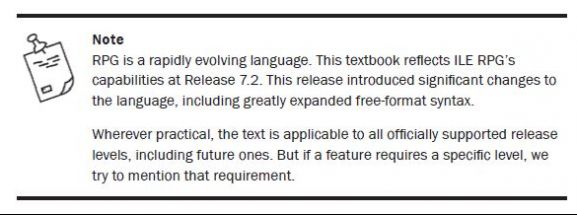

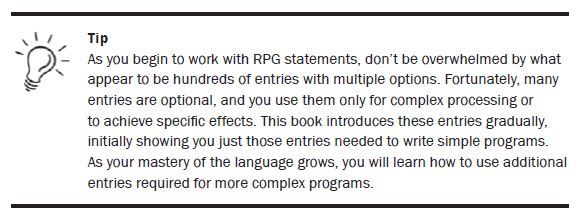
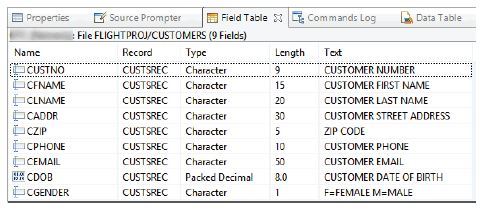
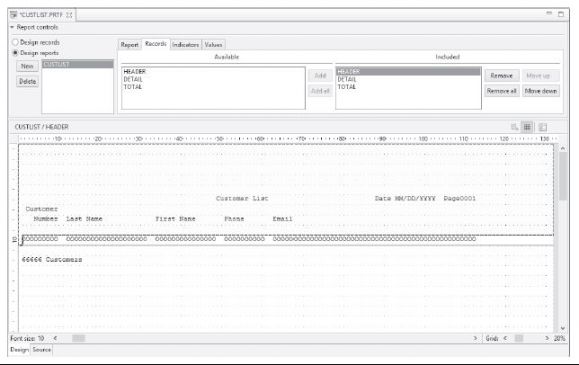
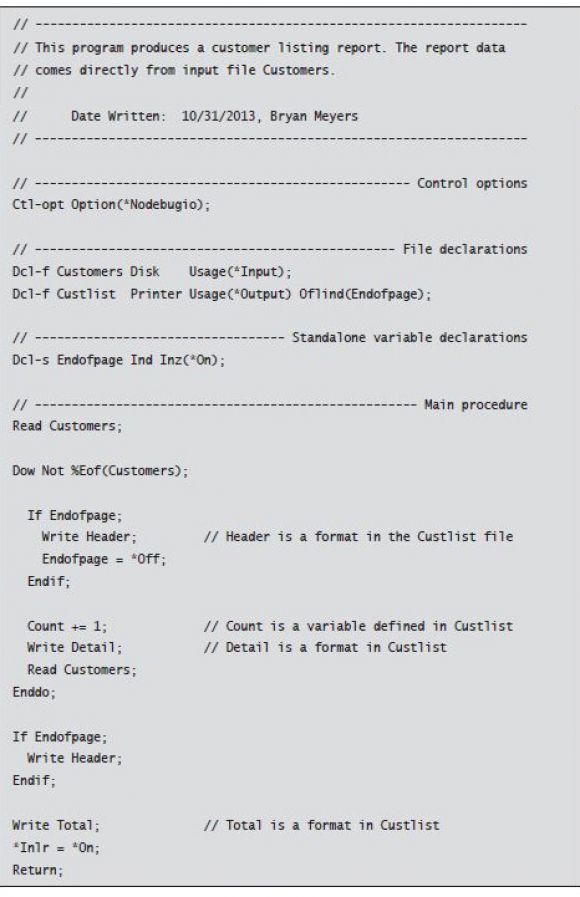



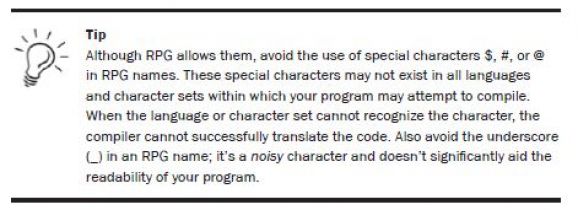
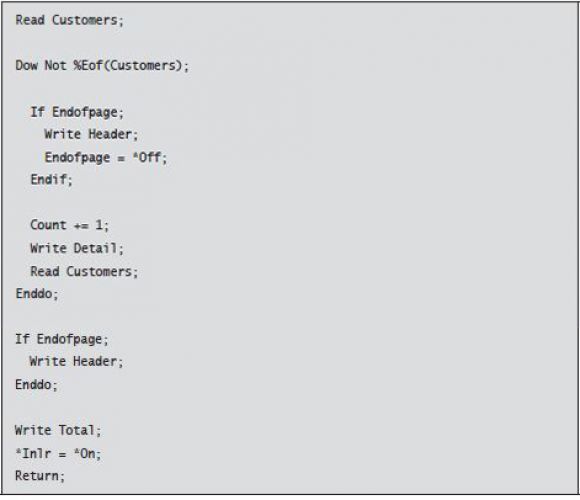









 More than ever, there is a demand for IT to deliver innovation. Your IBM i has been an essential part of your business operations for years. However, your organization may struggle to maintain the current system and implement new projects. The thousands of customers we've worked with and surveyed state that expectations regarding the digital footprint and vision of the company are not aligned with the current IT environment.
More than ever, there is a demand for IT to deliver innovation. Your IBM i has been an essential part of your business operations for years. However, your organization may struggle to maintain the current system and implement new projects. The thousands of customers we've worked with and surveyed state that expectations regarding the digital footprint and vision of the company are not aligned with the current IT environment. TRY the one package that solves all your document design and printing challenges on all your platforms. Produce bar code labels, electronic forms, ad hoc reports, and RFID tags – without programming! MarkMagic is the only document design and print solution that combines report writing, WYSIWYG label and forms design, and conditional printing in one integrated product. Make sure your data survives when catastrophe hits. Request your trial now! Request Now.
TRY the one package that solves all your document design and printing challenges on all your platforms. Produce bar code labels, electronic forms, ad hoc reports, and RFID tags – without programming! MarkMagic is the only document design and print solution that combines report writing, WYSIWYG label and forms design, and conditional printing in one integrated product. Make sure your data survives when catastrophe hits. Request your trial now! Request Now. Forms of ransomware has been around for over 30 years, and with more and more organizations suffering attacks each year, it continues to endure. What has made ransomware such a durable threat and what is the best way to combat it? In order to prevent ransomware, organizations must first understand how it works.
Forms of ransomware has been around for over 30 years, and with more and more organizations suffering attacks each year, it continues to endure. What has made ransomware such a durable threat and what is the best way to combat it? In order to prevent ransomware, organizations must first understand how it works. Disaster protection is vital to every business. Yet, it often consists of patched together procedures that are prone to error. From automatic backups to data encryption to media management, Robot automates the routine (yet often complex) tasks of iSeries backup and recovery, saving you time and money and making the process safer and more reliable. Automate your backups with the Robot Backup and Recovery Solution. Key features include:
Disaster protection is vital to every business. Yet, it often consists of patched together procedures that are prone to error. From automatic backups to data encryption to media management, Robot automates the routine (yet often complex) tasks of iSeries backup and recovery, saving you time and money and making the process safer and more reliable. Automate your backups with the Robot Backup and Recovery Solution. Key features include: Business users want new applications now. Market and regulatory pressures require faster application updates and delivery into production. Your IBM i developers may be approaching retirement, and you see no sure way to fill their positions with experienced developers. In addition, you may be caught between maintaining your existing applications and the uncertainty of moving to something new.
Business users want new applications now. Market and regulatory pressures require faster application updates and delivery into production. Your IBM i developers may be approaching retirement, and you see no sure way to fill their positions with experienced developers. In addition, you may be caught between maintaining your existing applications and the uncertainty of moving to something new. IT managers hoping to find new IBM i talent are discovering that the pool of experienced RPG programmers and operators or administrators with intimate knowledge of the operating system and the applications that run on it is small. This begs the question: How will you manage the platform that supports such a big part of your business? This guide offers strategies and software suggestions to help you plan IT staffing and resources and smooth the transition after your AS/400 talent retires. Read on to learn:
IT managers hoping to find new IBM i talent are discovering that the pool of experienced RPG programmers and operators or administrators with intimate knowledge of the operating system and the applications that run on it is small. This begs the question: How will you manage the platform that supports such a big part of your business? This guide offers strategies and software suggestions to help you plan IT staffing and resources and smooth the transition after your AS/400 talent retires. Read on to learn:
LATEST COMMENTS
MC Press Online